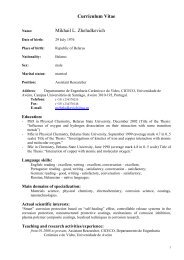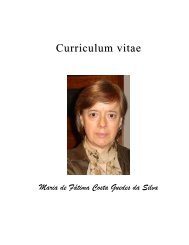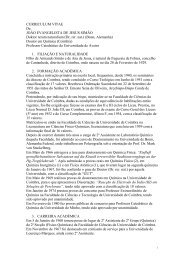XII Iberian Meeting of Electrochemistry XVI Meeting of the ...
XII Iberian Meeting of Electrochemistry XVI Meeting of the ...
XII Iberian Meeting of Electrochemistry XVI Meeting of the ...
Create successful ePaper yourself
Turn your PDF publications into a flip-book with our unique Google optimized e-Paper software.
<strong>XII</strong> <strong>Iberian</strong> <strong>Meeting</strong> <strong>of</strong> <strong>Electrochemistry</strong> & <strong>XVI</strong> <strong>Meeting</strong> <strong>of</strong> <strong>the</strong> Portuguese Electrochemical Society PE 14<br />
Ru<strong>the</strong>nium(II) and Iron(II) Complexes bearing<br />
low band-gap thiophenic ligands as possible N L O switches<br />
Tiago J. L. Silva 1 , Paulo J. G. Mendes 2 , M. Helena Garcia 1 ,<br />
M. Paula Robalo 3<br />
1 Faculdade de Ciências, Universidade de Lisboa, Campo Grande, 1749-001 Lisboa, Portugal<br />
2 Centro de Química de Évora, R. Romão Ramalho 59, 7000-671 Évora, Portugal<br />
3<br />
ADEQ/ISEL, R. Conselheiro Emídio Navarro, 1, 1959-007 Lisboa<br />
tjsilva@fc.ul.pt<br />
Over <strong>the</strong> past decade, <strong>the</strong>re was growth <strong>of</strong> interest in discovering new conducting<br />
molecules due to <strong>the</strong>ir potential applications in electrochromic devices, sensors, OLED's<br />
and more recently molecular switches. Non-Linear Optics (NLO) phenomenons, namely<br />
Second-Harmonic Generation (SHG), is one <strong>of</strong> <strong>the</strong> recently topics in molecular<br />
<br />
electrochemically changed in or<br />
switch, upon a redox process.<br />
Monocyclopentadienyliron (II) and ru<strong>the</strong>nium (II) complexes, combined with thiophene<br />
ues and<br />
have been widely studied for NLO [2]. Regarding <strong>the</strong> switching properties, oxidation in<br />
<strong>the</strong> transition metal, from M (II) to M (III) (M=Fe, Ru), can drastically reduce <strong>the</strong> NLO<br />
properties <strong>of</strong> <strong>the</strong>se molecules and <strong>the</strong>refore it provides a way to electrochemically<br />
on<strong>of</strong>f<br />
In this communication, monocyclopentadienyliron (II) and ru<strong>the</strong>nium (II) complexes<br />
bearing thiophene ligands (Figure 1) with low band-gaps will be electrochemically<br />
tested as possible molecules for NLO switching. The electrochemical results will be<br />
correlated with spectroscopic data and <strong>the</strong> NLO properties predicted by DFT<br />
calculations, in order to anticipate <strong>the</strong> potentialities <strong>of</strong> <strong>the</strong> new compounds as molecular<br />
switches.<br />
Figure 1 Elucidating picture <strong>of</strong> <strong>the</strong> studied ru<strong>the</strong>nium complexes<br />
Acknowledgments: We thank to COMPETE/F EDER for financial support (F COMP-01-0124-<br />
F EDER-007433).<br />
References<br />
[1] Coe, Benjamin, Acc. Chem. Res., 2006, 39, 383<br />
[2] a) Garcia, M. H., et al, J.Organomet. Chem., 2009, 694, 433. b) Mendes, P. et al, J. Mol.<br />
Struct.: THEOCHEM, 2010, 946, 33. c) Mendes, P. et al, J. Mol. Struct.: THEOCHEM, 2009,<br />
900, 110.<br />
September, 811, 2010. ISEL - Lisbon 105








